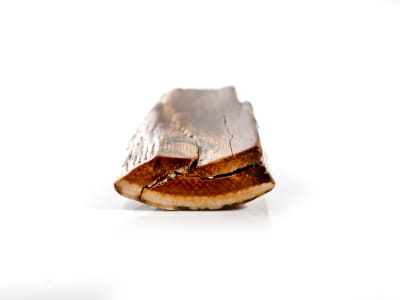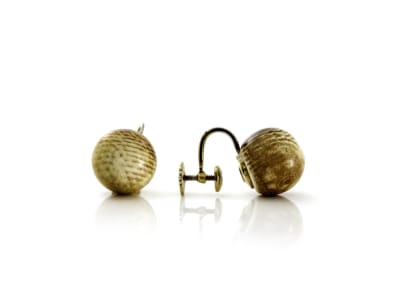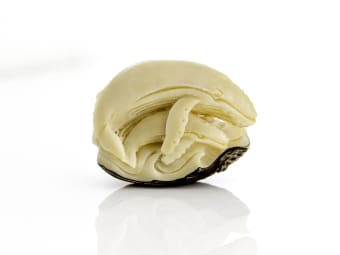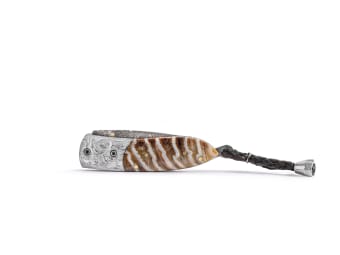Ivory has long been treasured for its beautiful white color and ability to be finely carved. As opposed to bone or horn, ivory is derived from the teeth and tusks of animals. Because of the devastating impact of poaching due to the ivory trade, the importation and sale of such materials is severely restricted or banned in many countries.
General Information
LWUV: weak to strong bluish white or violet blue
Ivory Colors
-
 Brown
Brown -
 White
White -
 Yellow
Yellow
Alternate Names
Babirusa Tusk Ivory, Boar tusk Ivory, Dugong Tusk Ivory, Elephant Ivory, Elk Teeth Ivory, Hippopotamus Ivory, Killer & Pilot Whale Teeth Ivory, Mammoth Ivory, Mastodon Ivory, Narwal Tusk Ivory ,Seal Teeth Ivory, Sperm Whale Ivory, Walrus Ivory, Warthog Tusk Ivory
Countries of Origin
Unknown
History
Elephant ivory was widely used for piano keys, billiard balls, combs, and decorative items from the mid-1800’s to the early 1900’s. Whale or walrus ivory were used by Whalers to create scrimshaw artifacts.
Care
Bone and ivory are very soft and may discolor with time. Discoloration is due to porosity/absorption of body oils or other substances from wearing. Be mindful of scratching. Avoid chemicals and ultrasonic cleaners. Requires gentle handling
Simulants
Vegetable Ivory
Ivory nut or vegetable ivory is a tagua nut which is the seed from some varieties of palm trees. It is white to pale yellow in its natural state. Since it resembles animal ivory it has been used as an ivory substitute in carvings, jewelry, buttons, and dice.
Species/Variety
Mammoth Ivory
Mammoths have been extinct for 10,000 years. The ivory has been well preserved for 20,000 years in the permafrost in Siberia and Alaska. Mammoth ivory has also been called fossil ivory, but the material is not truly a fossil because the organic material has not been replaced with minerals. It can be tan to dark brown, orange, blue to black in color. The brown or blue-green color is caused by staining by the iron phosphate mineral vivianite. This staining will not be found in modern elephant ivory.
Elephant Ivory
Elephant ivory comes from adult African and Asian elephants. The trade in elephant ivory is restricted or prohibited due to the animals endangered or threatened status with CITIES. Elephant tusks were harvested for their use in decorative objects. Demand for ivory dates to the 1st century BC in Asia. Demand for Ivory in Europe and North America hit its peak in the mid 1800’s to the 1930’s. Current trade in the west is restricted by governmental laws and is discouraged by the environmental community.
Walrus Ivory
Walrus tusks and teeth are used in scrimshaw and carved for decorative items by the indigenous peoples of Alaska, Greenland and Russia. Walrus is a protected species in the United States it can only be harvested by Alaskan Natives that use it to create art objects. As of this writing walrus ivory harvested before 1972 can be traded in the United States. As Walrus tusks can grow to 3 feet in length and the teeth are typically under 2 inches.
Hippopotamus Ivory
Hippopotamus Ivory is used for knife handles and decorative objects. The teeth range from 6 inches to a foot from the gum line. Hippopotami are not currently endangered but are a listed species under CITIES. Tanzania and Uganda formally traded in Hippopotamus Ivory, but pressure has been put on these countries to end the trade of the material.
Narwhal Ivory
Narwals are small artic whales. The males have a long, spirally twisted tusk that typically grows to 6 feet in length. Whales are a protected species and cannot be sold in the United States. The medieval Europeans thought the tusk was the horn from a unicorn.
Sperm Whale Ivory
Sperm whales have the largest teeth of all the whale species. The teeth range from 2 to 6 inches in length. In the past whalers used their down time to carve whale teeth for scrimshaw art objects and knife handles. All whales are now a protected species and can no longer be hunted.
Warthog Tusks
Warthogs are a variety of pig that come from sub-Saharan Africa. The tusks can reach 20 inches in length. The tusks are used for carvings, scrimshaw, and knife handles.
Wild Boar Tusks
Wild boar is a member of the pig family that can be found all over the world. The size of the tusk ranges from 5 to 18 inches.




